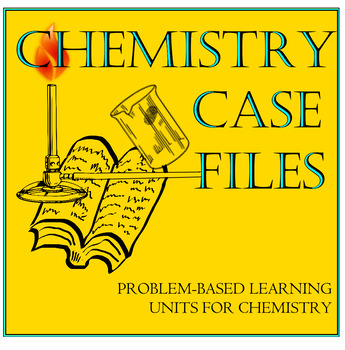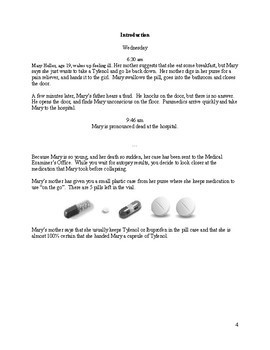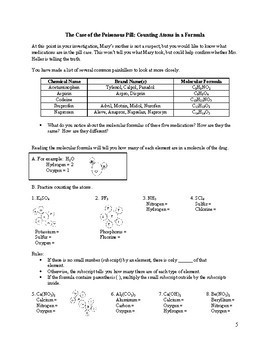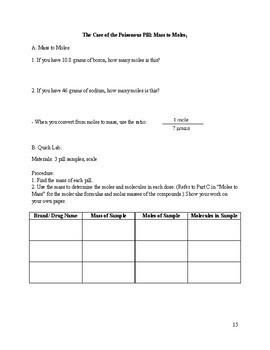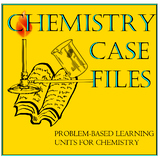Case of the Poisonous Pill: Chemistry "Moles" Story-lined Unit
What educators are saying
Also included in
- This BUNDLE consists of a year's worth of Chemistry Problem-Based Learning Units. They are also sold separately on TPT.All of the units have two sets of files. The "Classroom" files should be used in an in-person classroom setting. The "Absent" files can be used for long-term distance learning, homePrice $76.10Original Price $85.80Save $9.70
Description
The Case of the Poisonous Pill: A Problem-based "Moles" Unit for High School Chemistry
Summary:
A girl falls ill and dies after taking a medicine that her mother gives her. Soon other deaths are reported. The common factor in all of the cases is Extra-strength Tylenol.
Loosely based on the 1982 Chicago Tylenol murders, this problem-based learning investigation requires students to use moles, percent composition, and empirical formulas to determine why people keep dying after taking Tylenol.
For a list of materials and the first day activities, select the Preview.
Both the classroom version and the distance learning version follow the outline below. In the distance learning option, the case is presented using readings and videos.
This product is also part of a BUNDLE found here.
- Count atoms in a chemical formula;
- Define mole and apply the concept of molar mass to convert between moles and grams;
- Calculate the number of atoms or molecules in a sample of material using Avogadro's number;
- Calculate percent composition of compounds; and
- Differentiate between empirical and molecular formulas.
Contents - Keys and teacher instructions included.
Day 1:
Introduction - A girl dies after taking a common medication given to her by her mother. The mother says that she gave the girl Tylenol from her purse and gives you a small pill case. You want to know the identities of the other pills in the case.
Counting Atoms in a Formula - Students learn to count the atoms in a formula and apply this to the formulas of several known medications.
Counting Atoms in a Sample - Students estimate number items using mass.
Day 2:
Introducing the Mole - Particle to moles calculations
A Game of Dominoes - Scaffolding strategy
Types of Pain Killers - Reading on classifications of painkillers and how they work
Day 3:
Moles to Particles Practice - Practice with particle-to-moles calculations
Moles to Mass - Students convert moles to mass and determine the formula/ molar masses of several known medications.
Day 4:
Overdose - Students use moles to calculate the amount of medication needed to cause an overdose.
Day 5:
Percent Composition I - Students find the percent composition of an egg and learn to calculate the percent composition of elements in a compound.
Percent Composition Practice WS - Practice with percent composition and moles
Day 6:
Percent Composition II (Day 1) - Students perform a lab to decide if two pills are identical by comparing the percent compositions of their active ingredient and binder.
Case File - Students practice making inferences.
Day 7:
Percent Composition II (Day 2)
Empirical Formulas - Students learn to calculate empirical formulas to determine what medications the victim’s mother has in her purse.
Day 8:
Molecular Formulas - Students learn to calculate molecular formulas.
More Victims - Further case update.
Fatal Dose - Students practice mole calculations, empirical formulas, and molecular formulas to determine whether a fatal dose of a poison could fit in a Tylenol capsule.
Day 9:
Finish Fatal Dose
The Poison - Students use percent composition to finally identify the poison.
The Profile - Students write a criminal profile of their suspect.
Suspects - Students read about two suspects and decide if their is enough evidence to convict either.
Day 10:
Real Story of Tylenol Murders - Reading about the case.
Review (not included)
Copyright © E. Stubbe (The Wasp Whisperer)
All rights reserved by author.
Terms of Use: This document is for personal use only and may only be used by the original purchaser. This entire document, or any parts within, may not be reproduced or displayed for public viewing. You may NOT electronically post this product online including to teacher blogs, classroom websites or school networks. Failure to comply is a copyright infringement and a violation of the Digital Millennium Copyright Act (DMCA).

